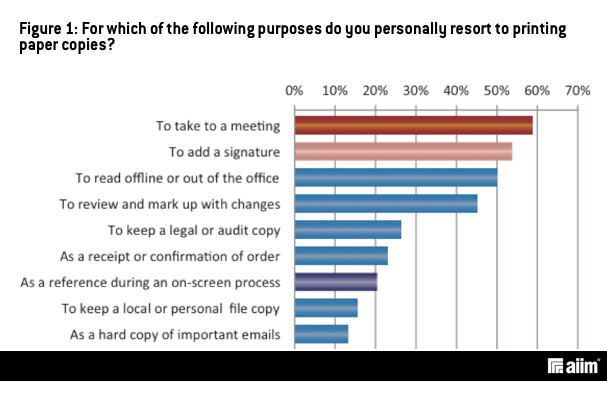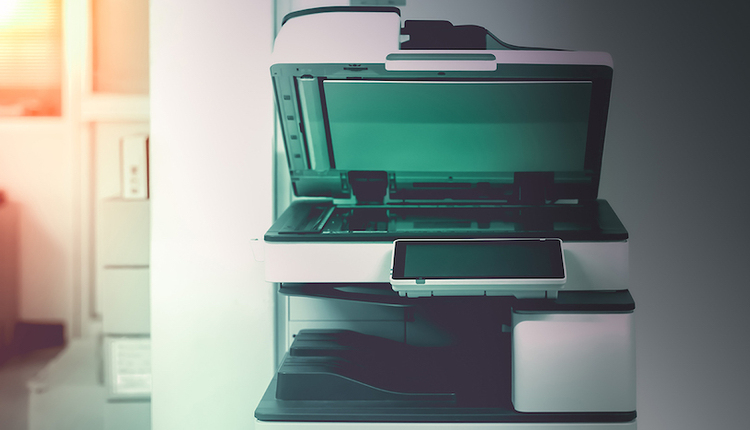
Paper is still a dominant part of many organizations, clogging and slowing processes. There are many reasons for it being present, including human reluctance to eliminate it. This is intriguing since many people bank online, shop online and even get receipts emailed when making a store purchase. Yet, paper in their business lives, for some reason, is still a comfortable place for many. The fact is that organizations are looking at operational efficiency and effectiveness improvements that remove paper from business processes in order to streamline workflows, increase flexibility and improve responsiveness. They understand that working at the speed of paper is not an acceptable mode of operation for the future.
In a recent AIIM report titled “Paper Wars 2014: Update from the Battlefield,” we find 68% of respondents agree that business-at-the-speed-of-paper will be “unacceptable in just a few years’ time.” Additionally, 46% consider that the biggest single productivity improvement for most of their business processes is to remove paper. This same report finds that the main reasons for paper use are to take notes to a meeting, add signatures and to read offline or out of the office, all of which can be done digitally.

Consider this
Most information used in business today is born digital, whether through a productivity app, email or other means. It is the human factor, and levels of comfort with the digital experience, that often slows or stops organizational transitions from the physical to digital information management environment. This is a change management issue rather than a technological one. The technology is here; we use it in our personal lives but, for some reason, are still reluctant to accept it in business. Taking paper to meetings, printing, signing and scanning to recapture in digital form and even to read offline are habits we made and habits we can break—only if we are willing to do so.
What to think about
Look at your business processes and identify where and how paper-based information is used. Are employees bringing stacks of paper to meetings and making notes on the pages? Could this be done using a tablet? Look at yourself and ask: Do I print documents for the same reason? Do I print and take them home? What about signatures? In the process, how many signatures are required? How many times is a document printed, signed and then scanned back into the system? How many copies of a document exist with single signatures on each, meaning, to get the full picture, you have to compile them in some way? Or do you print one, physically move it around to signers, wasting time, and then scan?
In my view
These days, there is little to no reason why a major portion of business cannot be done completely digital. Mobile devices provide access and portability in ways that we can take everything with us in digital format. Tools available allow us to digitally mark up documents and share the marked-up versions for correction. Use of digital signatures allows us to eliminate paper from the process and even engage mobile workers more immediately than ever before. So, why is there still so much paper?
Paper is here mainly because we choose it to be. There are exceptions of course, but for the most part, we no longer need paper in our processes. Culturally, you can try to move the organization beginning with yourself. Make a commitment to use mobile devices whenever and wherever possible for reading and document review. Look at signature processes and identify where and how digital signatures can be used. When you do this, look at the time and cost savings it will bring. It is not that hard; it just takes a commitment to change.
Look at your business processes and identify where and how paper-based information is used. Are employees bringing stacks of paper to meetings and making notes on the pages? Could this be done using a tablet? Look at yourself and ask: Do I print documents for the same reason? Do I print and take them home? What about signatures? In the process, how many signatures are required? How many times is a document printed, signed and then scanned back into the system? How many copies of a document exist with single signatures on each, meaning, to get the full picture, you have to compile them in some way? Or do you print one, physically move it around to signers, wasting time, and then scan?
In my view
These days, there is little to no reason why a major portion of business cannot be done completely digital. Mobile devices provide access and portability in ways that we can take everything with us in digital format. Tools available allow us to digitally mark up documents and share the marked-up versions for correction. Use of digital signatures allows us to eliminate paper from the process and even engage mobile workers more immediately than ever before. So, why is there still so much paper?
Paper is here mainly because we choose it to be. There are exceptions of course, but for the most part, we no longer need paper in our processes. Culturally, you can try to move the organization beginning with yourself. Make a commitment to use mobile devices whenever and wherever possible for reading and document review. Look at signature processes and identify where and how digital signatures can be used. When you do this, look at the time and cost savings it will bring. It is not that hard; it just takes a commitment to change.
Bob Larrivee is director of custom research at AIIM and an internationally recognized subject matter expert and thought leader with over 30 years of experience in the fields of information and process management. Follow him on Twitter @BobLarrivee.
















